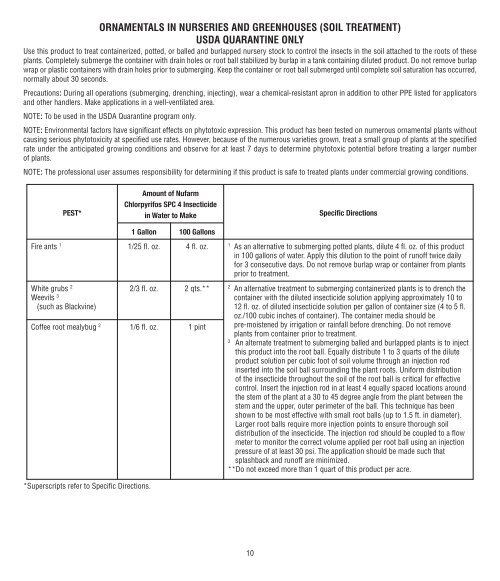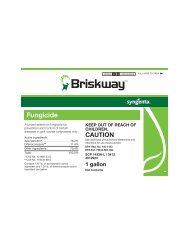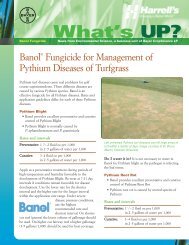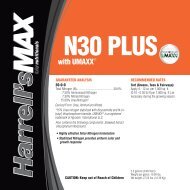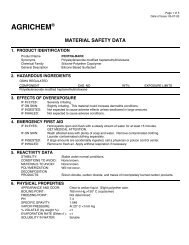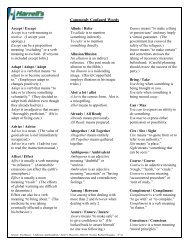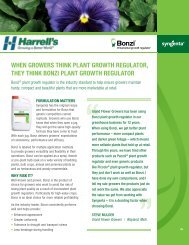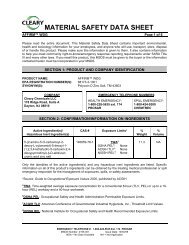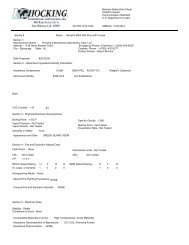Nufarm Chlorpyrifos SPC 4 label.pdf - Tom Irwin
Nufarm Chlorpyrifos SPC 4 label.pdf - Tom Irwin
Nufarm Chlorpyrifos SPC 4 label.pdf - Tom Irwin
Create successful ePaper yourself
Turn your PDF publications into a flip-book with our unique Google optimized e-Paper software.
<strong>Chlorpyrifos</strong>_<strong>SPC</strong>_4_INSCT.2.5G_Book_layout 1 11/9/10 3:21 PM Page 10<br />
ORNAMENTALS IN NURSERIES AND GREENHOUSES (SOIL TREATMENT)<br />
USDA QUARANTINE ONLY<br />
Use this product to treat containerized, potted, or balled and burlapped nursery stock to control the insects in the soil attached to the roots of these<br />
plants. Completely submerge the container with drain holes or root ball stabilized by burlap in a tank containing diluted product. Do not remove burlap<br />
wrap or plastic containers with drain holes prior to submerging. Keep the container or root ball submerged until complete soil saturation has occurred,<br />
normally about 30 seconds.<br />
Precautions: During all operations (submerging, drenching, injecting), wear a chemical-resistant apron in addition to other PPE listed for applicators<br />
and other handlers. Make applications in a well-ventilated area.<br />
NOTE: To be used in the USDA Quarantine program only.<br />
NOTE: Environmental factors have significant effects on phytotoxic expression. This product has been tested on numerous ornamental plants without<br />
causing serious phytotoxicity at specified use rates. However, because of the numerous varieties grown, treat a small group of plants at the specified<br />
rate under the anticipated growing conditions and observe for at least 7 days to determine phytotoxic potential before treating a larger number<br />
of plants.<br />
NOTE: The professional user assumes responsibility for determining if this product is safe to treated plants under commercial growing conditions.<br />
PEST*<br />
Amount of <strong>Nufarm</strong><br />
<strong>Chlorpyrifos</strong> <strong>SPC</strong> 4 Insecticide<br />
in Water to Make<br />
Specific Directions<br />
1 Gallon 100 Gallons<br />
Fire ants 1 1/25 fl. oz. 4 fl. oz. 1<br />
As an alternative to submerging potted plants, dilute 4 fl. oz. of this product<br />
in 100 gallons of water. Apply this dilution to the point of runoff twice daily<br />
for 3 consecutive days. Do not remove burlap wrap or container from plants<br />
prior to treatment.<br />
White grubs 2<br />
Weevils 3<br />
(such as Blackvine)<br />
Coffee root mealybug 2 1/6 fl. oz. 1 pint<br />
*Superscripts refer to Specific Directions.<br />
2/3 fl. oz. 2 qts.** 2<br />
An alternative treatment to submerging containerized plants is to drench the<br />
container with the diluted insecticide solution applying approximately 10 to<br />
12 fl. oz. of diluted insecticide solution per gallon of container size (4 to 5 fl.<br />
oz./100 cubic inches of container). The container media should be<br />
pre-moistened by irrigation or rainfall before drenching. Do not remove<br />
plants from container prior to treatment.<br />
3<br />
An alternate treatment to submerging balled and burlapped plants is to inject<br />
this product into the root ball. Equally distribute 1 to 3 quarts of the dilute<br />
product solution per cubic foot of soil volume through an injection rod<br />
inserted into the soil ball surrounding the plant roots. Uniform distribution<br />
of the insecticide throughout the soil of the root ball is critical for effective<br />
control. Insert the injection rod in at least 4 equally spaced locations around<br />
the stem of the plant at a 30 to 45 degree angle from the plant between the<br />
stem and the upper, outer perimeter of the ball. This technique has been<br />
shown to be most effective with small root balls (up to 1.5 ft. in diameter).<br />
Larger root balls require more injection points to ensure thorough soil<br />
distribution of the insecticide. The injection rod should be coupled to a flow<br />
meter to monitor the correct volume applied per root ball using an injection<br />
pressure of at least 30 psi. The application should be made such that<br />
splashback and runoff are minimized.<br />
**Do not exceed more than 1 quart of this product per acre.<br />
10


